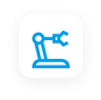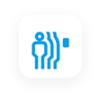It is said, “God created man in his own image.” Similarly, man created robots in his own image, albeit physically. While humans possess sense organs to function, robots have sensors that help them ‘feel’ the world.
Just as our society has advanced through several industrial revolutions, industrial robots are making phenomenal progress with the integration of emerging technologies like IIOT, AI/ML, AR/VR, and cloud computing. Industrial robots are becoming increasingly crucial as several industries adopt automation worldwide. These robots usually consist of different sub-systems interacting with each other and their environment to perform tasks.
One of the primary components is the robotic arm, embedded with several sensors. These sensors not only enable robots to accomplish various jobs but also safeguard the workplace from potential hazards. In this guide, we’ll explore the applications of robotic arms and the top sensors used to make them work.
Applications of Robotic Arms
Robotic arms are versatile with several applications in industries from manufacturing to automotive, and agriculture to healthcare. With an ever-increasing array of applications, the global robotic arms market is set to grow from US $26.2 bn in 2023 to US $77.2 bn in 2033.
They can perform tasks ranging from the simplest to the most complex in the safest or toughest surroundings. Whether it's welding, material handling, or even surgery, robotic arms have become capable of operating with utmost precision and safety, all thanks to hi-tech sensors.
Here are some of the most popular applications of robotic arms in industries today:
• Material Handling: Perform warehouse operations safely and efficiently with accelerated goods delivery and reduced accidents.
• Welding: Vision and AI can perform welding in complex industrial settings with high product quality.
• Palletizing: Safety laser scanners to automate the placement of goods onto pallets with higher accuracy and worker safety.
• Pick and Place: Advanced vision and distance sensors to identify, grasp, and relocate objects swiftly.
• Inspection: Vision and AI enable real-time quality checks, reducing waste and downtime.
The Top Sensors Used in Robotic Arms
Sensors are the key components that drive robotic machines. Sensors collect information from the real world and provide it to the robots to guide their every move and decision. Sensors measure parameters related to the robot itself as well as its surroundings.
Let’s explore some of the most common sensors used in robotic arms:
Force/Torque Sensors
These sensors measure the force and torque applied by the robot when working with other objects. They give feedback required to ensure gentle handling, precise fabrication, and safe operations.
Cobots use these sensors to create space enough to operate beside humans safely with faster response times on physical contact with humans.
Vision Sensors
These sensors come in the form of cameras combined with image-processing algorithms and ML/AI. They function as the ‘eyes’ of the robotic arm. They help robots locate and identify objects, inspect quality, and perform intricate tasks such as object manipulation.
Proximity Sensors
These sensors primarily detect nearby objects and prevent collisions with them. They can also measure the distances of objects from the robots accurately.
Cobots are increasingly embedded with these sensors since when they work with human workers, safety is paramount.
Inertial Sensors
These sensors measure changes in the alignment, position, and angular velocity of the arm. They maintain its orientation and stability, ensuring smooth and controlled movements in critical operations.
LiDAR (Light Detection And Ranging) Sensors
These sensors help robots map their environment in 3D and make movements by perceiving and identifying objects and avoiding collisions. LiDARs are attached to a robotic arm to form a safe space around it so humans can work beside it without any risk of harm.
Safety Sensors
While other sensors have individual primary functions and regard safety as only secondary, safety sensors are specially designed to protect personnel with high accuracy.
For instance, the UAM-05LP safety laser scanner offered by Hokuyo-USA is an excellent sensor that safeguards human workers from colliding with stationary or mobile robots (AGVs, AMRs). It helps robots with collision prevention and presence detection in unsafe zones.
Benefits of UAM-05LP:
• 5-meter safety zone and up to 20-meter warning zone
• A high scanning angle of 270°
• Encoder input and data output using Ethernet
• The smallest and lightest scanner on the market
• Designed to work in conditions such as varying temperature zones and harsh industrial environments
Hokuyo - Your Reliable Sensor Provider
The Fourth Industrial Revolution demands greater precision and stringent safety standards in industrial robotics and related technologies.
With the evolution of technology, high-quality sensors are available to make robotic arms more efficient, more productive, and safer.
At Hokuyo, we understand the value of precision and personnel safety. We offer a range of innovative and cutting-edge sensors such as distance sensors, LiDARs, and safety laser scanners for various applications in robotics.
Connect with us to learn more about our range of products and get optimized automation solutions.

 Factory Automation
Factory Automation Logistics Automation
Logistics Automation Process Automation
Process Automation Crane Collision Avoidance
Crane Collision Avoidance LiDAR/Obstacle Detection
LiDAR/Obstacle Detection Safety Laser Scanners
Safety Laser Scanners Optical Data Transmission
Optical Data Transmission Hot Metal Detectors
Hot Metal Detectors Laser Distance Sensor
Laser Distance Sensor Blog
Blog Whitepapers
Whitepapers Case Studies
Case Studies Infographics
Infographics